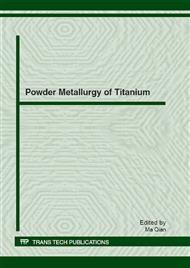p.121
p.133
p.139
p.145
p.153
p.161
p.167
p.174
p.181
Metal Injection Moulding of Titanium and Titanium-Aluminides
Abstract:
Metal injection moulding (MIM) attracts growing interest as an economic net-shape manufacturing technique for the processing of titanium and titanium alloys. Even for titanium-aluminides, intended for high-temperature applications, MIM is seen as a reasonable technique to overcome processing problems with conventional methods. In this paper, basic requirements in terms of raw materials, facilities and processing in order to produce high performance components are presented. Main focus is laid on the well-known Ti-6Al-4V alloy. It is shown that the tensile properties of specimens after MIM processing can exceed the requirements given by ASTM standards even without performing an additional HIP process. For an oxygen content ranging from 0.15 to 0.33 wt% plastic elongation yields excellent 14%. Fatigue measurements performed by means of 4-point-bending tests show that grain size is more important than residual porosity in order to achieve a high endurance limit. This is shown by addition of boron powder which refines the microstructure dramatically. The modified alloy Ti-6Al-4V-0.5B yields an endurance limit of 640 MPa compared to 450 MPa of MIM parts made from standard alloy powder. Sintered components from Ti-45Al-5Nb-0.2B-0.2C (at%) powder made by inert gas atomising (EIGA technique) and processed by MIM exhibit a residual porosity of only 0.2% and tensile properties comparable to cast material.
Info:
Periodical:
Pages:
153-160
Citation:
Online since:
August 2012
Price:
Сopyright:
© 2012 Trans Tech Publications Ltd. All Rights Reserved
Share:
Citation:


